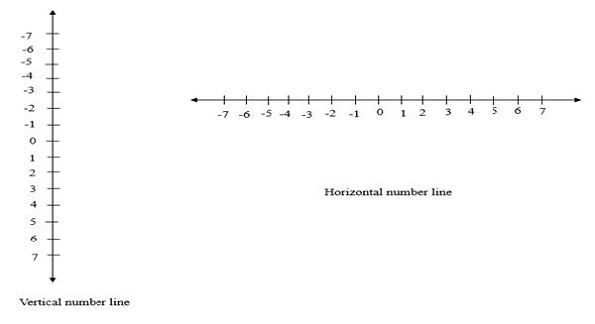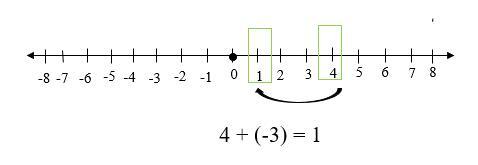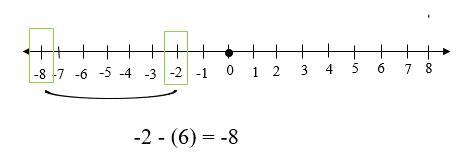
 Data Structure
Data Structure Networking
Networking RDBMS
RDBMS Operating System
Operating System Java
Java MS Excel
MS Excel iOS
iOS HTML
HTML CSS
CSS Android
Android Python
Python C Programming
C Programming C++
C++ C#
C# MongoDB
MongoDB MySQL
MySQL Javascript
Javascript PHP
PHP
- Selected Reading
- UPSC IAS Exams Notes
- Developer's Best Practices
- Questions and Answers
- Effective Resume Writing
- HR Interview Questions
- Computer Glossary
- Who is Who
Operations of Integers on Number Line
Introduction
Operations of integers such as addition, subtraction, multiplication, and division can be explained in the number line system. In our daily life, we need to perform various algebraic operations with numbers. There are various types of numbers used in mathematics. In specific, the integer is a special type of number widely used. The presentation and several mathematical operations of integers are necessary. In this tutorial, we will learn about the number systems, integers, their presentation on the number line, comparison and operation of the integers on the number line with solved examples.
Number System
A number is a mathematical term with some value used to count or measure objects. Various numbers are included in mathematics, such as natural numbers, integers, rational numbers, and irrational numbers. However, the number system is defined as the representation of numbers in various forms that computers can understand. The number system is also known as the numeral system. There are four types of number systems in algebra such as
Decimal (base-10) In this system, a total of 10 digits, i.e., 0, 1, 2, 3, 4, 5, 6, 7, 8, and 9
Binary (base-2) It uses only two digits, such as 0 and 1, to represent any number
Octal (base-8) It uses 8 digits, such as 0, 1, 2, 3, 4, 5, 6, and 7, to represent any number.
Hexadecimal (base-16) It uses 16 digits or alphabets, including 0, 1, 2, 3, 4, 5, 6, 7, 8, 9, and A, B, C, D, E, F.
Integers
The collection of numbers has whole and negative numbers but no fractional or ratio terms. That is, ? -4, -3, -2, -1, 0, 1, 2, 3, 4? are called integers. The integers are categorized into 3 types.
Positive integers If the value of the integers is greater than zero, they are called positive integers. For example, 4, 76, 5, 9, 34, and so on.
Negative integers If the value of the integers is smaller than zero, they are called negative integers. For example, -8, -10, -16, -100, -4, and so on.
Zero The number "0" is neither a positive nor negative integer. However, it is a whole number.
Number Line of integers
A number line is a graduated straight line marked with integers. There are two types of number lines in elementary mathematics such as horizontal and vertical integers. The numbers are equidistant in a number line. An example of number lines is given below.

It is also used to perform comparative analysis and algebraic operations between the integers. A number line has four parts.
Central part 0 is the origin or central part of the number line.
Left part The left part of the number line represents the negative integers
Right part The right part of the number line represents the positive integers.
Representation of Integers on Number Line
A number line has four parts.
Central part 0 is the origin or central part of the number line.
Left part The left part of the number line represents the negative integers.
Right part The right part of the number line represents the positive integers.

Let's consider that we have to represent the number 4. Then, we have to move 4 points to the right side of the zero.

Let's consider that we have to represent the number -6. Then, we have to move 6 points to the left side of the zero.

Comparing Integers on Number Line
The number line can be utilized to compare two integers. In comparing two integers, the integer located farther to the right is greater. Similarly, the integer that is located farther to the left is smaller.
For example, we have to compare -3 and 8. Since the integer "8" is farther to the right than "-3", 8 is greater than -3. It can also be written 8 > 3.

Similarly, compare 0 and -4. Since the integer "-4" is farther to the left than "0", therefore, -4 is smaller than 0. It can also be written as -4 < 0 or 0 > -4.

Operations of Integers Using Number Line
The four basic algebraic operations, such as addition, subtraction, multiplication, and divisions of integers, can be explained in the number line system.
Addition of integers:
The addition of integers on a number line can be carried out by observing the sign of the second integer. If the second integer is positive, we will move towards the right side, or else we will move towards the left side.
Let's consider an example. Add 4 and -3 using the number line. The following steps should be followed to find the addition of the above integers.
Mark the first integer, i.e., 4, on the number line.
Now, from the first number, move towards the left side with the same units as that of the second number.
$\mathrm{4\:+\:(-3)\:=\:1}$

Subtraction of integers:
The subtraction of integers on a number line can be carried out by observing the sign of the second integer. If the second integer is positive, we will move towards the left side or move towards the right side.
Let's consider an example. Subtract -4 from -1 using a number line. The following steps should be followed to find the subtraction of the above integers.
Mark the first integer, i.e., -1, on the number line.
Now, from the first number, move towards the right side with the same units as that of the second number.
$\mathrm{-1\:-\:(-4)\:=\:3}$

Multiplication of integers:
The multiplication of two integers can be done by using the following steps.
Start from zero and count by the first number as many times as indicated by the second number.
There are some rules in the multiplication of integers.
| $\mathrm{Positive\:\times\:Positive}$ | Positive |
| $\mathrm{Negative\:\times\:Positive}$ | Negative |
| $\mathrm{Positive\:\times\:Negative}$ | Negative |
| $\mathrm{Negative\:\times\:Negative}$ | Positive |
Division of integers:
The division of two integers can be done by using the following steps.
Select a definite line segment on a number line starting from zero.
Divide this segment evenly into the number of parts indicated by the second integer.
The length of each part will be the result of division.
Solved Examples
1) Subtract 6 from -2 using a number line.
Answer According to the question, we have to find the result of -2 - (6).
The following steps should be followed to find the subtraction of the above integers.
Mark the first integer, i.e., -2, on the number line.
Since the second integer is a positive number, therefore, from the first number, move towards the left side with the same units as that of the second number.
$\mathrm{-2\:-\:(6)\:=\:-8}$

2)Multiply 2 and -4.
Answer The following steps should be followed to find the multiplication of the above integers.
Take 0 as a reference.
Count by twos a total of four times, which gives the result of 8.
ince $\mathrm{Positive\:\times\:Negative\:=\:Negative}$, therefore, the result will be -8
Conclusion
The present tutorial gives a brief introduction to the basic concept of integers and the number line. The basic definition of the number system, integers, and number lines have been described in this tutorial. In addition, the presentation of the integers and their basic operations have been described using the number line. Moreover, some solved examples have been provided for better clarity of this concept. In conclusion, the present tutorial may be useful for understanding the basic concept of operations of integers on a number line.
FAQs
1. What will be the result of the division of two negative integers?
The division of negative integers is always a positive integer
2. Which numbers can be represented on a number line?
The number line can be used to represent natural numbers, integers, decimals, fractions, rational, and irrational numbers.
3. What is a double-number line?
The double number line is two parallel lines that represent the equivalent ratios. The location of tick marks matches on both number lines.
4. Define the base of a number system?
The base is defined as a whole number that can be used to represent the numbers. The most common base used in the decimal system is base 10.
5. What is an open number line?
If no numbers or integers are marked on the number line, it is called an open number line. It is usually used for the addition and subtraction of integers.

